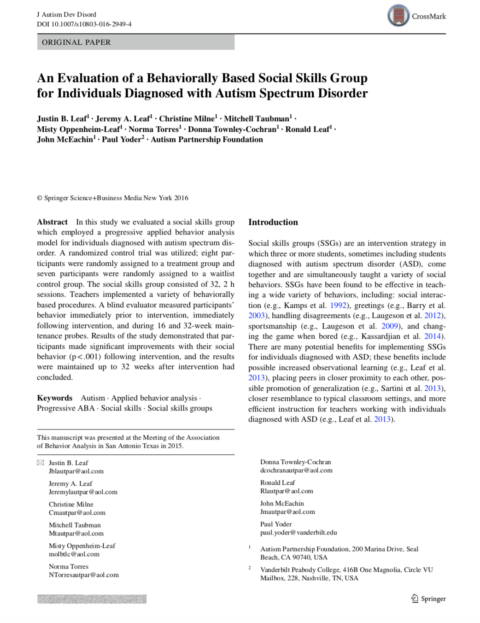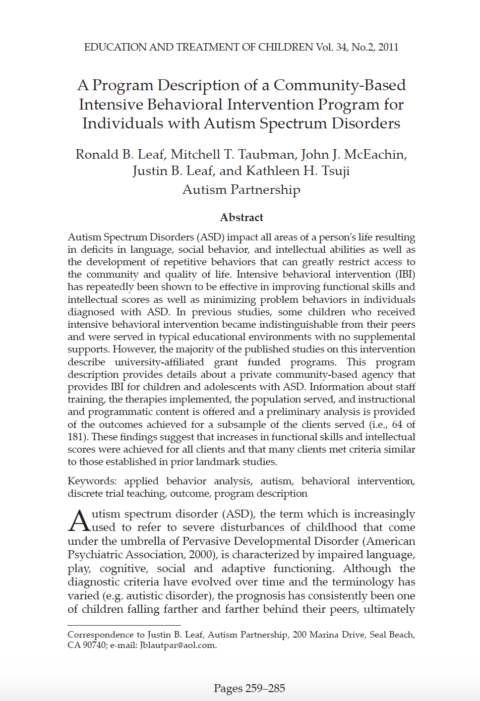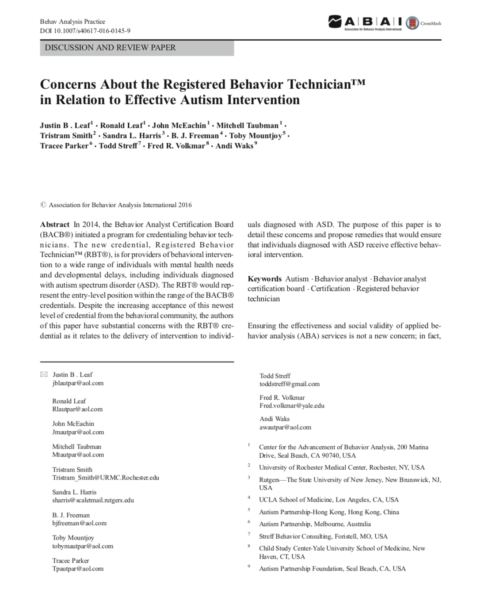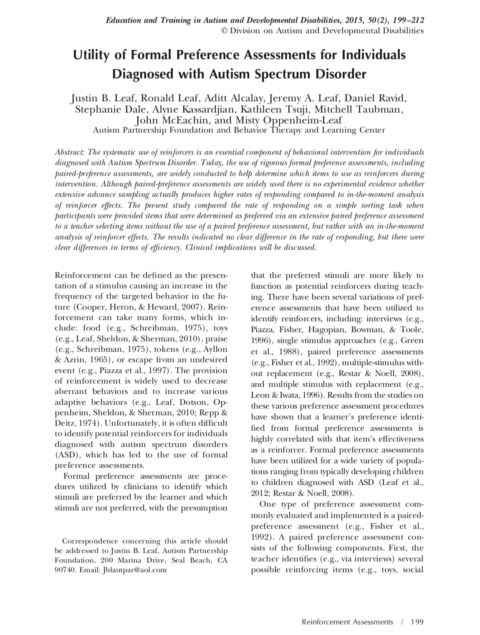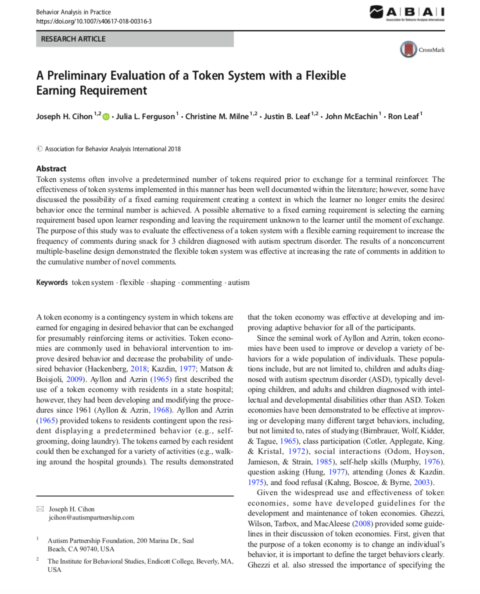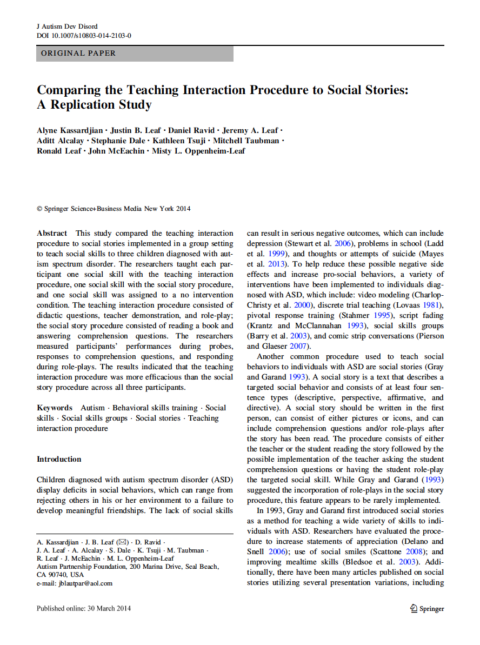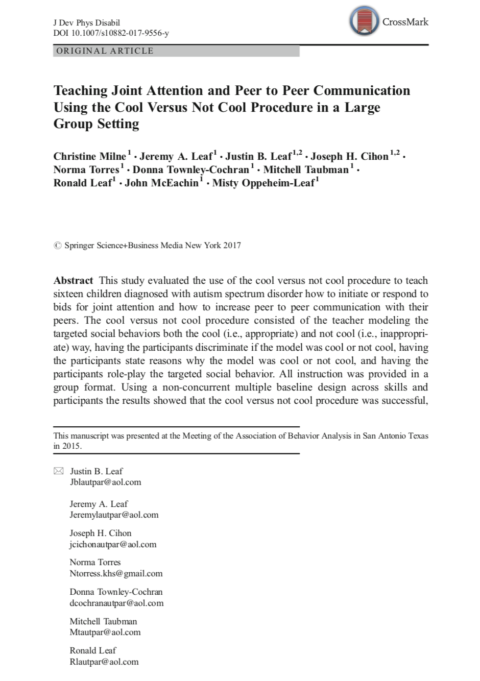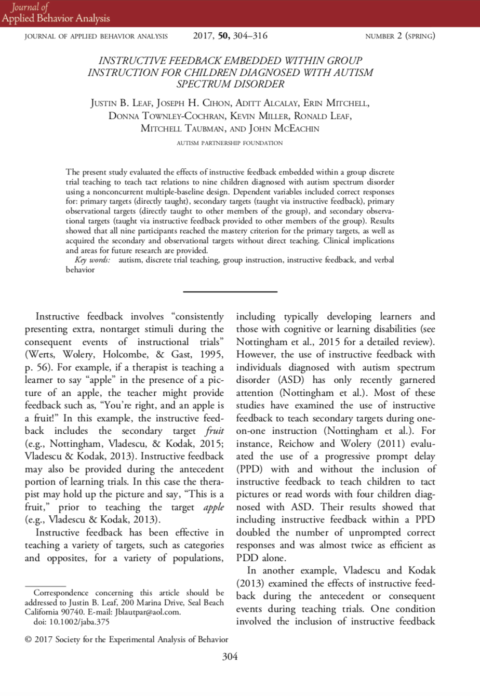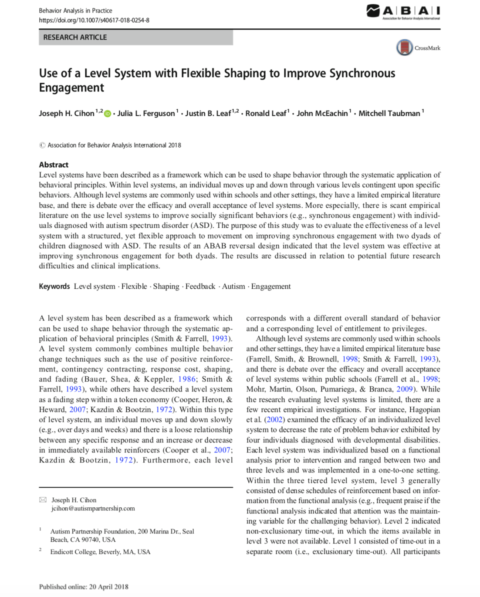At Autism Partnership Foundation, we have conducted social skills groups for children and adolescents diagnosed with autism spectrum disorder (ASD) for over 20 years and have seen incredible social gains as a result. This study evaluated a behaviorally based social skills group that lasted 16-weeks with children diagnosed with ASD between 4 and 6 years of age. The results showed children made significant progress on standardized assessments, and, more importantly, developed friendships with other members of the group.
Research Papers & Journal Articles
Autism Partnership has agencies around the world providing services for individuals diagnosed with autism spectrum disorder (ASD). This study evaluated the progress of 64 children at our agencies in Seal Beach, California; Hong Kong; Leeds, United Kingdom; and Melbourne, Australia. The results found that 70.3% of children achieved best outcome when ABA services were provided early (i.e., before the age of 8), intensive (i.e., 10-40 hours a week), by quality therapists, and programming was individualized for each child.
The rapid growth of the field of ABA has left it susceptible to unsophisticated, rigid approaches to autism intervention that are not sufficient to produce quality outcomes. This paper identifies some characteristics of quality ABA, which takes a structured, responsive, and flexible approach using on-going analysis of the effectiveness of teaching. Some characteristics discussed include progressive approaches to instructional arrangements, reinforcement, discrete trial teaching, curriculum, staff training and more.
The Registered Behavior Technician™ (RBT®) is a credential created by the Behavior Analyst Certification Board. The RBT® credential is primarily for those to provide direct service line intervention for individuals diagnosed with autism spectrum disorder (ASD). The number of RBTs® has risen exponentially since its creation in 2014. With the increasing number of RBTs®, this paper outlines concerns about the hours of required training (i.e., 40 hours), quality of intervention being provided, and the risks associated with not addressing these concerns.
It can sometimes be difficult to identify the preferences of individuals diagnosed with autism spectrum disorder (ASD). A common approach to solve this problem is the use of formal preference assessments. These can be long, labor intensive, and provide a narrow view of preference. Instead of formal preference assessments, the Autism Partnership Method uses in-the-moment assessment to identify preferences. This study compared a common formal preference assessment (i.e., paired-stimulus) to in-the-moment reinforcer analysis. Results demonstrated that in-the-moment reinforcer analysis was more efficient and just as effective as a paired-stimulus preference assessment at identifying the preferences of individuals diagnosed with ASD.
Token systems are commonly used throughout the course of intervention for individuals diagnosed with autism spectrum disorder (ASD). Most token systems have a fixed earning requirement (e.g., always 10 tokens before exchange), which could create a context in which the individual no longer emits the desired behavior once the requirement is achieved. Within the Autism Partnership Method, we have used a token system with a flexible earning requirement, called the “magic number,” in which the individual is unaware of how many tokens they need to earn. This study demonstrated the effectiveness of the magic number token system during a snack time with three children diagnosed with ASD.
Despite several reviews questioning the effectiveness if Social Stories™, they are a common intervention targeting social skills for individuals diagnosed with autism spectrum disorder (ASD). Within the Autism Partnership Method, social skills are commonly taught using the Teaching Interaction Procedure. This study compared the two interventions (i.e., Social Stories™ and the Teaching Interaction Procedure) to teach social skills for three children diagnosed with ASD. Results demonstrated the Teaching Interaction Procedure was effective for all three children while the Social Story™ intervention was not effective for any of the children.
The Cool versus Not Cool™ procedure is a social skills intervention commonly used in the Autism Partnership Method that teaches the cool (i.e., appropriate) and not cool (i.e., inappropriate) way to engage in social behavior. This is done through modeling the social behavior the cool and not cool way, having the individual decide if and why the model was cool or not cool, and having the individual role-play. This study demonstrated the effectiveness of the Cool versus Not Cool™ procedure to teach joint attention in a social skills group setting for several children diagnosed with autism spectrum disorder.
Instructive feedback is an approach to improve the efficiency of teaching that involves providing additional information during an instruction or praise. For example, when teaching the label “apple,” the interventionist might provide the praise, “It is an apple! An apple is a fruit!” This study involved teaching children diagnosed with autism spectrum disorder (ASD) popular superheroes within a small group using an instructive feedback approach. The superheroes superpowers were provided as instructive feedback. Results showed the efficiency of the approach in that the children learned their targeted superheroes, their superpowers through instructional feedback, and their peers’ targets through observational learning.
Level systems are commonly used within the Autism Partnership Method. When using a level system, an individual moves up levels for engaging in the desired behavior and down levels for engaging in undesired behavior. This study evaluated the use of a level system using in-the-moment assessment to determine movement to improve mutually enjoyable play between two children diagnosed with autism spectrum disorder (ASD). The results showed the level system was effective in that both pairs of children engaged in more mutually enjoyable play when the level system was in use.

